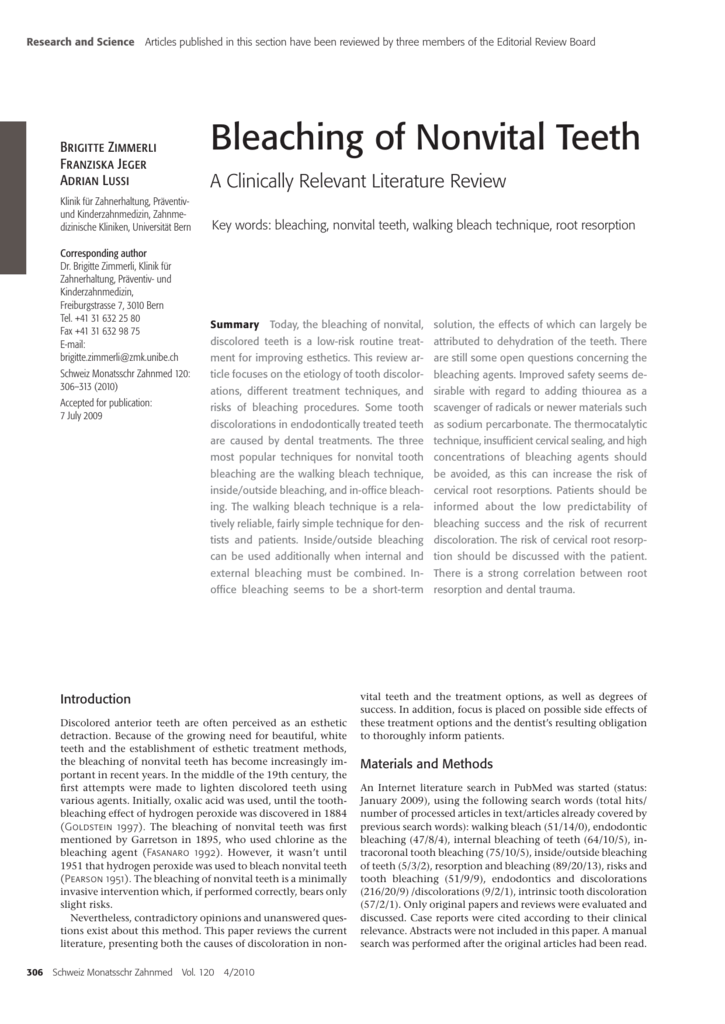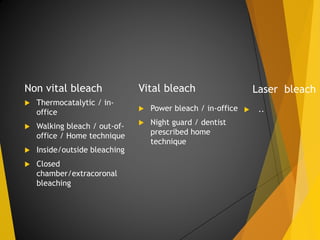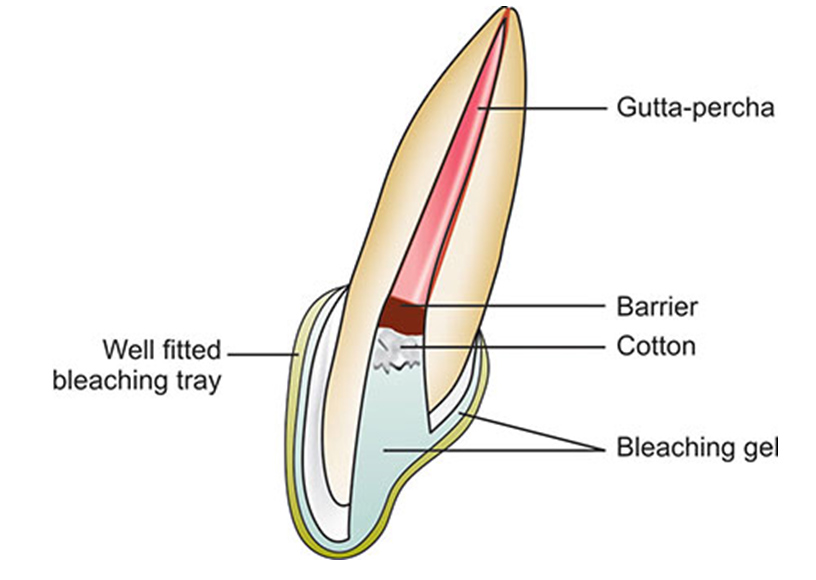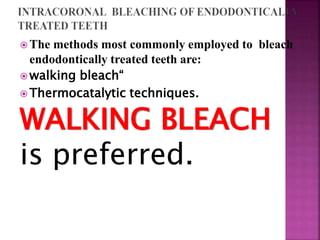walking bleach technique
Walking bleach is a bleaching procedure performed at a dental clinic. Used in non vital endodontically treated.

Pdf The Efficacy Of Walking Bleach Technique In Endodontically Treated Teeth Case Report
Its use is therefore prohibited since April 2015.

. However sodium perborate has been classified as carcinogenic mutagenic and toxic for reproduction by European Union legislation. Management of intrinsic discoloration using walking bleach technique in maxillary central incisors Clujul Med. Internal bleaching procedures such as the walking bleach technique can be used for whitening of discoloured root-filled teeth.
At our office todays widely used internal bleaching technique known as walking bleach is applied. This finding however does not suggest that the positive results seen in both groups were attributable to the walking bleach technique. Another name of Walking Bleach is Intracoronal bleaching.
The walking bleach technique i. To evaluate the. Traumatic dental injuries pulp necrosis pulp tissue remnants after endodontic therapy internal resorption etc can be effectively and safely corrected with walking bleach internal bleaching technique.
The Walking Bleach Technique The Walking Bleach Technique Putter Harvey. Tooth discolouration as a result of intrapulpal hemorrhage ie. By admin June 29 2020 0 Comments.
This technique is a conservative alternative to a more invasive esthetic treatment such as. Ambulatory techniques when high concentrations of hydrogen peroxide and carbamide peroxide are used require different types of sources for gel activation such as light heat or laser. Root canal treatments may discolour teeth due to the materials used to fill the root canal discolouration breakdown of blood in the root canal and medications used in the root canal during the.
Nonvital bleaching was performed with a walking bleaching technique consisting of four sessions of bleach application. Before the placement of bleaching gel Opalescence Endo into the tooth the so-called pulp chamber. National Center for Biotechnology Information.
In summary the walking bleach technique using 35 hydrogen peroxide or 37 carbamide peroxide demonstrated similar effectiveness in this study with large changes in average tooth color. Given by Nutting and Poe. 1989-11-01 000000 METHOD For optimum results the following technique should be adhered to.
Over the past decades the walking bleach technique using sodium perborate was considered a safe and effective method to bleach nonvital discolored teeth. All teeth received traditional biomechanical root canal instrumentation after which the walking bleach agent was placed in the pulp chamber space. The most popular bleaching technique is the walk-ing bleach technique in which many bleaching agents have been used.
The anterior dentitions are photographed using a Polaroid CU5 camera. Initial tooth color using an appropriate shade guide is documented. The bleaching agent should be changed every 3-7 days.
Whitening of nonvital endodontically treated teeth by walking bleach technique is a time-consuming procedure which requires multiple visits. Non-vital bleaching is a non-invasive technique to treat the intrinsic discoloration of teeth of several etiologies. At the end of each visit the bleaching agent is left in.
The purpose of this study was to compare the in vitro sealing capacity of five materials each used as a temporary sealing agent for the walking bleach technique. In the walking bleach technique the root filling should be completed first and a cervical seal must be established. Generally a paste of sodium perborate mixed with either hydrogen peroxide or water is sealed in the pulp chamber by a temporary restoration and changed every 3 to 7 days until tbe desirable sbade re-.
Samples were obtained from six periodontal sites for each bleached tooth. Hydrogen peroxide and sodium perborate are commonly used bleaching. The tooth involved is usually non vital and should be endodontically treated.
Gingival crevicular fluid samples were taken in order to quantify the RANK-L and IL-1β levels by enzyme-linked immunosorbent assay. The thermocatalytic technique involves placement of a bleaching agent in the pulp chamber followed by heat application. It involves bleaching the tooth from the inside of the tooth.
The walking bleach technique is used to whiten teeth that have had root canal treatments. This a reliable and efficient technique of internal beaching which does not require the patient sit for too long a time in the dental chair. Three vestibular and.

Intracoronal Bleaching Of Nonvital Teeth Pocket Dentistry

Non Vital Internal Bleaching Prestige Dental Care Com My

Pdf Non Vital Tooth Bleaching Techniques A Systematic Review

Pdf Walking Bleach With Sodium Perborate Tetrahydrate A Safer Material And Method

Bleaching Of Nonvital Teeth Swiss Dental Journal Sso Mit

Bleaching Of Discoloured Tooth Ppt

An Effective Bleaching Technique For Non Vital Discoloured Teeth In Children And Adolescents Semantic Scholar

Pdf Non Vital Tooth Bleaching Techniques A Systematic Review Semantic Scholar

Bleaching Of Non Vital Tooth Semantic Scholar

Kids Are Using Too Much Toothpaste Bad Dental Health Habits Delta Dental Of Arizona Blog Tips For Healthy Teeth Happy Smiles Dental Health Health Habits Mouth Health

Dos And Donts In Dentistry Walking Bleach Technique

Dos And Donts In Dentistry Walking Bleach Technique
Intracoronal Bleaching Of Nonvital Tooth Teeth Whitening

An Effective Bleaching Technique For Non Vital Discoloured Teeth In Children And Adolescents Semantic Scholar








0 Response to "walking bleach technique"
Post a Comment